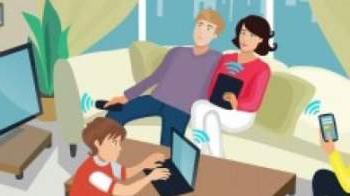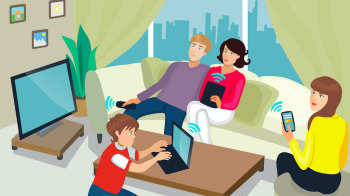The decline of the TV centric living room
IAB UK study shows devices compete equally with TV for consumer attention in the modern living room.
在这里查看研究
The degree to which the rise of internet-connected devices has impacted the traditional TV watching living room dynamic is revealed today by an in-depth study from the IAB UK exposing two key myths about this traditional routine.
The Real_Living study – carried out by award winning research agency, 有火花的1,050 people and was measured by a mixture of surveys, 被动拍摄, 设备内置跟踪, daily diaries and biometric data (via skin sensors to measure Electrical-Dermo Activity, 又名参与). The study also includes data from the National Grid and British Gas.
Myth 1: TV is the dominant living room screen and entertainment the dominant activity
Only 50% of UK online adults now say the TV set is the focal point of their living room, whilst 70% report they ordinarily use a connected device whilst watching TV – this rises to 87% of 16-34s. 多设备活动在晚上6-9点之间达到高峰.
在电视节目中, 超过三分之一(34%)的人会查看电子邮件, 31% Instant Message or text and 25% shop online.
The biometric data revealed that about 60% of the time a person is most highly engaged during an evening TV session is in non-TV related activity, such as using a digital device or talking to someone.
“Second screening is ingrained to such a degree that all screens are now equal, 没有等级制度, only fragmentation of attention – actually switch-screening is a much more accurate term,蒂姆·埃尔金顿说, IAB的首席战略官. “此外, entertainment is only a small part of the living room media activity. It’s now a multifunctional space where people jump between individual and group activities, 无论是购物, 社交媒体, 电子邮件, 工作或信息.”
Myth 2: TV programmes and ad breaks determine behaviour
The study revealed the traditional assumption that people cram non-TV related behaviour into the ad breaks is no longer valid.
例如, the incidence of checking 电子邮件 is consistent during TV programmes and ad breaks (both 34%) whilst texting or Instant Messaging is only 1% higher during the ad break than the programme. 设备追踪显示, 整体, there was actually more online activity per minute during a programme than an ad break.
此外, the declining “kettle power surge” during ad breaks in peak TV occasions over the last 25 years provides more evidence of the change in the traditional rhythm of the living room. During the biggest TV event in 1990 – England’s World Cup semi-final against West Germany – National Grid data compiled by British Gas shows a power surge equivalent to 1.12 million kettles boiling at the same time immediately after the match. In 2014’s biggest TV event – England’s World Cup match against Uruguay – the power surge was the equivalent of only 410,000个沸腾的水壶.

Elkington says: “Connected devices and the realities of modern life mean behaviour in the living room is no longer determined by TV programmes and ad breaks, it is determined by the natural rhythm of device usage.”
Among the various activities people do during an ad break, the one they do most often is going online via a connected device (35%) followed by talking to someone in the room (15%), leaving the room (13%) and changing the channel (8%).

E.g. among the various activities people engage in during ads, using a connected device is the one done most often (cited by 35% of respondents)
“Connected devices have changed the living room and will continue to do so, and advertisers must plan for the living room of tomorrow,埃尔金顿总结道. “This requires a rethink about how to command attention in the living room because the opportunity to do so is far more limited, fragmented and competitive than ever before.”
重新发现彩乐园dsn的乐趣
支持连接而不是点击. Capture audiences' imaginations, not just their attention. Boldly move to your own beat instead of letting tech set the pace. It’s time to rediscover the joy of digital.


